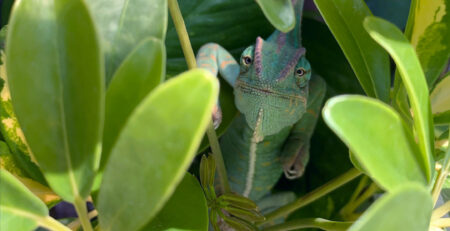April 6: Female Veiled Chameleon Feeding
Listen Here!
We are making progress in our drive to determine the feeding schedule and husbandry to maintain healthy female veiled chameleons through their lives – especially including egg laying. By controlling their diet and conditions we can reign in their body’s enthusiasm for making eggs. By providing greater than ideal conditions their body creates more eggs than are healthy. Today I share progress made by Mari Joki from Finland.
Mari's Recipe

The following are the care conditions that Mari Joki used to produce a reasonable size clutch of Veiled Chameleon eggs. This is still at the point where we need more people to use this information to replicate the results. Please contact me at bill@chameleonacademy.com if you try this recipe out or if you have one of your own that has been successful.
Mari Joki Husbandry Recipe
Ambient Daytime Temperatures: 22-24 C
Basking Temperatures: 28-30 C
Nighttime Temperatures: 15-16 C
Hydration: Night time fogging
UV Index at Basking: UVI 3
Supplementation: Arcadia Earth Pro A and pollen with every feeding
Feeding Schedule:
0-3 Months: Ad Libitum
3 Months* forward: 2 feeders every other day
Females 4 weeks before mating until egg laying: 4 feeders every other day
*Note that babies graduate to the reduced diet when they are well started as per breeder’s judgement. This is, on average, three months. But babies are evaluated individually.
This schedule is the baseline. Each individual is monitored to ensure they are slowly gaining weight as is appropriate. If they are too skinny or losing weight then their intake is increased.
Laying Bin: 10cm deep; 4 inches deep
Diet: BSFs, silkworms and moths, crickets and banana roaches, a superworm every now and then.
It is important that we continue this work for the sakes of our female veiled chameleons. MBD is, arguably, the biggest killer of veiled chameleons. Next in line would be egg laying complications. And these complications are, overwhelmingly, due to inadequate husbandry. If you would like to join in figuring this out please share how you got a clutch in the 20s or 30s.













